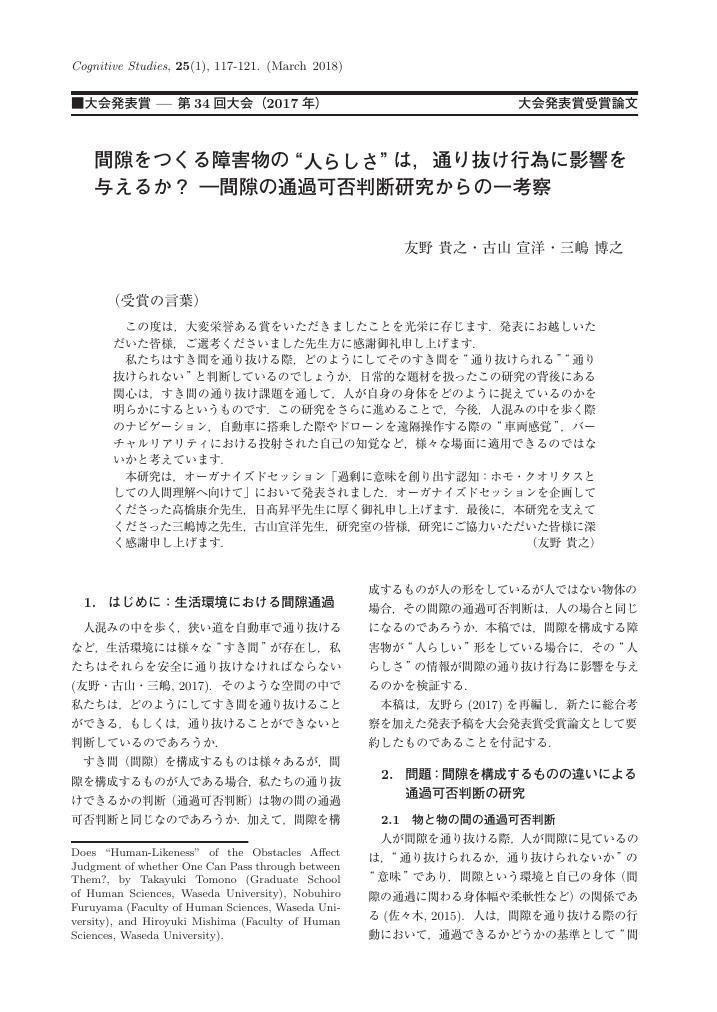9 0 0 0 OA 人はいかにして人と人の間を通り抜けられると判断するのか?
- 著者
- 友野 貴之 古山 宣洋 三嶋 博之
- 出版者
- 日本認知科学会
- 雑誌
- 認知科学 (ISSN:13417924)
- 巻号頁・発行日
- vol.24, no.3, pp.435-449, 2017-09-01 (Released:2018-03-01)
- 参考文献数
- 24
- 被引用文献数
- 1
When walking through a crowd, we have to pass through between people safely. How do we judge the passability of an aperture of this kind? Do we use the same information for an aperture composed of people as for one composed of other objects? Because studies on personal space have revealed that people have different sensitivities of personal space for approach from different directions (i.e., “anisotropy” of personal space) (Tanaka, 1973), we examined human aperture passability in terms of personal space in two experiments. In Experiment 1, the participants judged whether they could,without rotating their shoulder, pass between two stationary people or between two rectangular wooden posts. The two people to be passed through stood in four different orientations relative to one another and/or the participants; face-to-face, back-to-back,side-by-side facing towards or away from the participants. The wooden posts, which had the same width and depth as the two people, were set up in two directions (the wider sides facing each other vs. the narrower sides facing each other). In Experiment 2, the participants judged whether they could pass between two stationary people or between two human-shaped panels, which were set up in four different directions as in Experiment 1. In the analyses, we used the aperture-to-shoulder-width ratio (A/S) as an index of aperture “passability” judgment (Warren & Whang, 1987). We found that A/S was larger in the face-to-face condition than the other conditions. This is possibly because personal space is “anisotropic.” That is, when judging the passability of a space between two people, participants may consider the anisotropic personal space of each person. We also found that A/S was not significantly different across the board, implying that participants may have perceived a kind of “personal space” of the human-shaped objects, regardless of whether they were human or non-human.
2 0 0 0 OA 靴紐の締め方の強弱が若年者の歩行動作に与える影響
- 著者
- 村野 良太 佐藤 健 友野 貴之 加藤 麻樹
- 出版者
- 一般社団法人 日本人間工学会
- 雑誌
- 人間工学 (ISSN:05494974)
- 巻号頁・発行日
- vol.59, no.3, pp.103-112, 2023-06-15 (Released:2023-06-21)
- 参考文献数
- 38
本研究は靴紐の締め方の強弱(tightness)が歩行動作に与える影響を明らかにすることを目的とした.実験参加者は男性9名(22.8±1.2歳),女性9名(21.9±1.8歳)とし,歩行課題(自然歩行,努力歩行)と靴紐の締め方の強弱(fit条件,loose条件)を操作した歩行実験を行った.Kinect v2を用いた歩行姿勢測定システムで歩行速度,歩幅,歩隔を,体幹2点歩行動揺計で歩行周期時間,胸椎背部(以下,Th6)および仙骨付近(以下,S2)における3方向(左右,上下,前後)の平均動揺量とHarmonic Ratio(以下,HR)を計測,算出した.すべての分析項目を用いて対応のある二元配置多変量分散分析を実施した結果,歩行課題と靴紐条件について主効果が認められた.loose条件ではfit条件よりも,歩行速度,S2の上下動揺量,Th6の上下方向のHRは有意に小さく,Th6の左右動揺量,S2の前後動揺量は有意に大きかった.本研究より,靴紐の締め方が緩い(loose条件)と歩行中の体幹の動きに影響を与えることが示された.
1 0 0 0 OA すき間を通り抜けること: 間隙通過研究の動向と課題(1987~2019年)
- 著者
- 友野 貴之 山本 敦 古山 宣洋 三嶋 博之
- 出版者
- 日本認知科学会
- 雑誌
- 認知科学 (ISSN:13417924)
- 巻号頁・発行日
- vol.27, no.3, pp.386-399, 2020-09-01 (Released:2020-09-15)
- 参考文献数
- 79
This paper reviews the research on how one passes through an aperture between non-human objects or between humans. In particular, we discuss what it has so far elucidated and what should be investigated in the future. The previous studies have focused on aperture passability between non-human physical objects and revealed the relationship between how people actually pass through an aperture and how they perceive themselves in relation to environmental characteristics by looking at how people judge passability of an aperture (often formalized as π-number). Most researchers have attended to the factors associated with an actor passing an aperture and/or non-human objects constituting an aperture, but few have examined how one passes an aperture comprised of humans. This may be because it is difficult to experimentally control underlying factors such as conversations and/or physical/social interactions between humans, symmetry of an aperture due to different shapes of the human body, anisotropic shape of personal space, eye gaze, and/or eye contact. Despite these difficulties, we consider it important to study how people pass an aperture between humans, because, first and foremost, that is what we do in everyday life, and, secondly, the outcome will illuminate how people consider socio-cultural factors, personal space,opportunities of actions (i.e., affordances) by ourselves and others. Possible solutions to the difficulties may include use of virtual reality technologies, computer simulation to control the experimental settings to guarantee reproducibility. There are the pros and cons with these methods to discuss, because, depending on how they are employed, they may possibly spoil the very social and interactive (improvisational) nature of the phenomenon under discussion.
